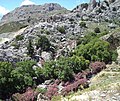Stegna, Rhodes
This article needs additional citations for verification. (April 2018) |
Stegna
Στεγνά | |
|---|---|
 Stegna | |
| Coordinates: 36°12′N 28°08′E / 36.200°N 28.133°ECoordinates: 36°12′N 28°08′E / 36.200°N 28.133°E | |
| Country | Greece |
| Administrative region | South Aegean |
| Regional unit | Rhodes |
| Municipality | Rhodes |
| Elevation | 4 m (13 ft) |
| Community | |
| • Population | 57 (2011) |
| Time zone | UTC+2 (EET) |
| • Summer (DST) | UTC+3 (EEST) |
Stegna (Greek: Στεγνά) is a small village and part of the former municipality of Archangelos on the island of Rhodes, in the Dodecanese, Greece. Since the 2011 local government reform it is part of the municipality of Rhodes.[2]
Location and population[]
Stegna is located about 30 kilometers south of the town of Rhodes on the island's east coast close to the sea. The nearest town of Archangelos, Rhodes town is 3 kilometers away.
Stegna has a picturesque bay and is also a small holiday resort with tavernas, restaurants, bars and apartments close to the beach. Stegna is only half an hour drive from Rhodes International Airport, and 20 minutes drive from Lindos.
The population according to the 2011 census was 57, while in the 2001 census it was 231.[3] Most residents of Stegna are inhabitants of the nearby town Archangelos, Rhodes.

Stegna - Panoramic view

Stegna - View from the street

Stegna - View of the beach

Stegna - View of the bay

Stegna - View of the mountains
History[]
Stegna was a fishing village and a cultivation place, mostly with orange and olive groves. Archangelos, Rhodes and Stegna are also well known since the ancient greek times for their potters. [4]
Economy[]
Major economic resources include tourism, fishing and agriculture (main agricultural products are olive oil and citrus fruits).
Tourist attractions[]
Nearby:
- castle of Saint George ruins
- cave of Koumellos
- church of Saint Michael Archangel
See also[]
- Archangelos, Rhodes
- Haraki
References[]
- ^ a b "Απογραφή Πληθυσμού - Κατ��ικιών 2011. ΜΟΝΙΜΟΣ Πληθυσμός" (in Greek). Hellenic Statistical Authority.
- ^ "Στεγνά (Δωδεκανήσου), local government changes". EETAA. Retrieved 10 September 2021.
- ^ "Population & housing census 2001 (incl. area and average elevation)"
- ^ Corinth, the Centenary, 1896-1996 - Volume 20 - Page 461
| Wikimedia Commons has media related to Stegna (Rhodes). |
- Populated places in Rhodes





